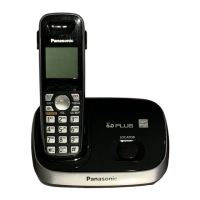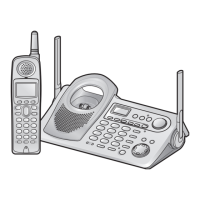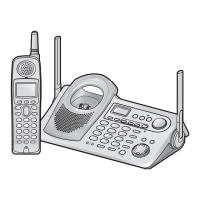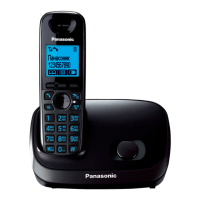Why is my Panasonic KX-TG6524 base unit not ringing?
- MMichael YoungSep 14, 2025
If the base unit of your Panasonic Cordless Telephone does not ring, check if the ringer volume is turned off and adjust it.

Why is my Panasonic KX-TG6524 base unit not ringing?
If the base unit of your Panasonic Cordless Telephone does not ring, check if the ringer volume is turned off and adjust it.
Why does the handset beep and/or flash on my Panasonic KX-TG6524 Cordless Telephone?
If the handset of your Panasonic Cordless Telephone beeps and/or flashes, fully charge the batteries.
Why does my Panasonic Cordless Telephone beep and flash?
If your Panasonic Cordless Telephone handset beeps and/or the phone icon flashes, it indicates that the battery charge is low. You should fully charge the batteries.
How to fix no dial tone on Panasonic KX-TG6524 Cordless Telephone?
If you cannot hear a dial tone on your Panasonic Cordless Telephone, ensure the base unit’s AC adaptor or telephone line cord is properly connected. If the connections are correct, disconnect the base unit from the telephone line and connect the line to a known working telephone. If the working telephone operates properly, contact our service personnel to have the unit repaired. If the working telephone does not operate properly, contact your service provider/ telephone company.
Why can't I make long distance calls on my Panasonic KX-TG6524 Cordless Telephone?
If you cannot make long distance calls on your Panasonic Cordless Telephone, make sure that you have long distance service.
What to do if my Panasonic KX-TG6524 got wet?
If liquid or other moisture has entered your Panasonic Cordless Telephone handset/base unit, disconnect the AC adaptor and telephone line cord from the base unit. Remove the batteries from the handset and leave to dry for at least 3 days. After drying, reconnect the AC adaptor and telephone line cord, insert the batteries, and charge fully before use. If it still doesn't work, contact an authorized service center.
What to do if my Panasonic KX-TG6524 displays only an underscore?
If your Panasonic Cordless Telephone displays only an underscore '_', it could mean the handset is too far from the base unit, so move closer. Another reason might be that the base unit's AC adaptor isn't properly connected; try reconnecting it. Also, ensure the handset is registered to the base unit.
Why is my Panasonic KX-TG6524 Cordless Telephone not recording messages?
If your Panasonic Cordless Telephone does not record new messages, first check if the answering system is turned off and turn it on. If the message memory is full, erase unnecessary messages. Also, verify that the recording time isn't set to “Greeting only”, and change the setting if it is. If you subscribe to a voice mail service, messages are recorded by your service provider, so you may need to adjust the number of rings or contact your service provider.
What to do if I cannot operate the answering system remotely on my Panasonic Cordless Telephone?
If you cannot operate the answering system remotely on your Panasonic Cordless Telephone, the remote access code may not be set, so set the remote access code. You might be entering the wrong remote access code; if you have forgotten it, enter the remote access code setting to check your current code. Ensure you press each key firmly. Also, the answering system may be turned off, so turn it on.
Why is caller information not displayed on my Panasonic KX-TG6524?
Several factors can cause caller information not to be displayed. First, ensure you subscribe to Caller ID service. If your unit connects to additional telephone equipment such as a Caller ID box or cordless telephone line jack, plug the unit directly into the wall jack. If you use a DSL/ADSL service, consider connecting a DSL/ADSL filter between the base unit and the telephone line jack. Also, the name display service may not be available in some areas, or other telephone equipment may be interfering with this unit, so disconnect the other equipment and try again.
| Brand | Panasonic |
|---|---|
| Model | KX-TG6524 |
| Category | Cordless Telephone |
| Language | English |
Details the different models and their part numbers for base units and handsets.
Compares features like answering system, caller ID, and intercom across different series.
Information regarding the product's compliance with ENERGY STAR guidelines for energy efficiency.
Lists supplied accessories such as AC adaptors and telephone line cords for various unit configurations.
Provides details on ordering optional accessories like rechargeable batteries and headsets.
Explains how to expand the phone system by registering optional handsets and using range extenders.
Critical safety warnings related to power connection, installation, and usage to prevent injury or damage.
Guidelines for safe operation, including cleaning, not disassembling, and avoiding liquids.
Advises consulting medical device manufacturers regarding RF energy and usage in healthcare facilities.
Instructions on battery use, handling, charging, and disposal, including warnings about short circuits and explosions.
Tips for optimal performance, including base unit placement and environmental factors.
Basic safety precautions for product use, including avoiding water, electrical storms, and gas leaks.
Guidelines for cleaning the product's outer surface using a soft moist cloth.
Includes cautions on battery replacement, privacy of information, and product design for US use.
Step-by-step instructions for connecting the base unit, installing batteries, and charging the handset.
Important notes on connections, power failures, battery installation, and charging for a smooth setup.
Explains the feature that reduces power consumption by adjusting handset transmission power.
Identifies and explains the functions of buttons and indicators on the handset and base unit.
Details the controls on the KX-TG6521/KX-TG6531 series and KX-TG6541 series handsets and their functions.
Instructions for attaching a belt clip and explains various handset display icons and their meanings.
Guides on setting display language, voice guidance language, dialing mode, and date/time.
Instructions for changing dialing mode and setting the current date and time for the unit.
Explains how to make calls using the handset, speakerphone, and redial list, including volume adjustment.
Details how to use the pause feature for PBX or long-distance service users when making calls.
Guides on answering calls using the handset and base unit, including auto-talk and ringer volume adjustments.
Explains how to use Hold, Mute, and Flash features during conversations for better call management.
Details features like Call Waiting, Temporary Tone Dialing, Handset Clarity Booster, Call Share, and Privacy Mode.
Instructions on adding, correcting, and organizing phonebook entries, including group assignments.
Guides on searching, editing, and deleting entries in the shared phonebook by character or group.
Explains how to dial numbers from the phonebook while on an outside call, useful for access codes.
Introduces methods for customizing the unit via display menus or direct commands.
Provides direct command codes for programming various features like Caller list, Intercom, and Alarm.
Instructions for setting an alarm for each handset, including options for once or daily alarms and alarm tones.
Guides on setting silent mode to prevent ringing during specific times, useful for undisturbed periods.
Instructions for customizing handset names and setting up call blocking for unwanted numbers.
Explains how to store up to 30 phone numbers in the call block list via caller list or direct entry.
Step-by-step guide for registering additional handsets to the base unit or re-registering existing ones.
Allows a handset to cancel its own registration or another handset's registration from the base unit.
Explains how Caller ID works, displays caller information, and notes for PBX systems and missed calls.
Details the feature that announces the caller's name or number, with notes on pronunciation and limitations.
Allows assigning different ringer tones to phonebook groups for easier caller identification.
Provides information on accessing, viewing, and editing the caller list entries.
Explains how the unit automatically edits area codes for called numbers for convenient dialing.
Guides on how to save caller information directly from the caller list into the phonebook.
Covers setting up the answering system, turning it on/off, and managing message memory capacity.
Allows listening to callers leaving messages through the unit's speaker, with volume adjustment.
Instructions for recording your own greeting, using pre-recorded messages, and resetting to default.
Explains how to play back new or all messages using the base unit, indicated by a flashing message indicator.
Details keys for controlling playback: repeat, skip, stop, erase, and accessing menus.
Guides on listening to new or all messages using the handset, indicated by 'New message' display.
Covers calling back callers from caller ID and erasing all recorded messages.
Instructions for accessing answering system functions remotely using a touch-tone phone.
Details how to dial in, enter access code, use voice guidance, and remote commands for system control.
Guides on changing number of rings, recording time, and selecting 'Greeting only' mode.
Explains how to enable or disable the message indicator on the handset for new messages.
Explains voice mail as a service from your provider and how to use it instead of the unit's answering system.
Instructions for storing the voice mail access number to enable automatic dialing and message alerts.
Details how to turn VM tone detection on/off and listen to voice mail messages.
Explains how to make and answer intercom calls between handsets and the base unit.
Guides on how to locate a misplaced handset by paging it from the base unit.
Details how to transfer outside calls and establish conference calls between parties.
Instructions for mounting the base unit on a wall and setting it up to stand on a desk.
Lists common error messages displayed on the unit and their corresponding causes and solutions.
Addresses issues like handset not turning on, unit not working, no dial tone, and handset flashing slowly.
Troubleshooting steps for display language issues and problems registering a handset to the base unit.
Troubleshooting for battery issues, noise during calls, and problems with ringing or making calls.
Solves problems with caller information display, announcement delays, and editing phone numbers.
Addresses time shifts, 2nd caller info not displaying, and problems with recording or operating the answering system.
Troubleshoots remote operation errors and issues related to liquid damage to the unit.
Covers FCC rules, REN, connection requirements, and compatibility with telephone company services.
Details FCC RF exposure warnings, compliance with TIA-1083 standard, and hearing aid compatibility.
Provides contact information, website, and phone numbers for product information and assistance.
Information on purchasing parts, accessories, and instruction books online or via mail/phone.
Details the warranty period, options for repair or replacement, and exclusions for parts and labor.
Details the warranty period, options for repair or replacement, and exclusions for parts and labor.
Provides instructions for sending the product for repair, including required documentation and packing.
Outlines what is NOT covered by the warranty, including normal wear and tear and accidental damages.
Troubleshooting steps to take if the product is not functioning correctly, including checking connections and batteries.
Recommends keeping purchase information for warranty assistance, including serial number and dealer details.












